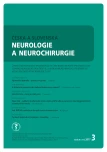Results of Endocrine Function after Transsphenoidal Surgery for Non-functional Pituitary Macroadenomas
Authors:
V. Novák 1; L. Hrabálek 1; Z. Fryšák 2; J. Hoza 3; C. Hučko 3; D. Krahulík 1
; J. Macháč 1; M. Vaverka 1
Authors‘ workplace:
Neurochirurgická klinika
LF UP a FN Olomouc
1; III. interní klinika – nefrologická
revmatologická a endokrinologická
LF UP a FN Olomouc
2; Otolaryngologická klinika
FN a LF UP Olomouc
3
Published in:
Cesk Slov Neurol N 2017; 80/113(3): 286-290
Category:
Original Paper
doi:
https://doi.org/10.14735/amcsnn2017286
Článek nebyl podpořen formou grantu, přístrojového vybavení nebo léků.
Overview
Aim:
The aim of this study was to assess changes to endocrine pituitary function following pituitary macroadenoma surgery and to compare the microscopic and endoscopic techniques.
Methods:
A study group included patients with nonfunctional pituitary macroadenoma undergoing microscopic or endoscopic transnasal transsphenoidal approach at the Department of Neurosurgery of the University Hospital in Olomouc. All patients underwent neurologic, radiologic and endocrinology examination before and after surgery. All data were retrospectively reviewed and both techniques were statistically compared.
Results:
A total of 78 patients were included in this study. In patients without preoperative hormonal abnormalities, postoperative deficit occurred more often in the microscope group (47.4%) compared to endoscopic group (40%) but the difference was not statistically significant (p = 0.761). In patients with a preoperative hormonal abnormality, postoperative deterioration of hormonal functions was more frequent again in the microscope-operated (70%) compared to the endoscopic group (21.4%), the difference was statistically significant (p = 0.015).
Conclusion:
In our study, endoscopic technique achieves better postoperative results of pituitary hormonal functions compared to microscopic techniques, particularly in patients with preoperative hormonal abnormality.
Key words:
hypopituitarism – transsphenoidal surgery – nonfunctional pituitary adenoma – endocrine deficit
The authors declare they have no potential conflicts of interest concerning drugs, products, or services used in the study.
The Editorial Board declares that the manuscript met the ICMJE “uniform requirements” for biomedical papers.
Chinese summary - 摘要
非功能性垂体大细胞瘤的经蝶窦手术后内分泌功能的研究目标:
本研究的目的是评估垂体大细胞瘤手术后内分泌垂体功能的变化,并比较微观和内窥镜技术。
方法:
研究组包括非功能性垂体大腺瘤患者在奥洛穆茨大学医院神经外科系进行微观或内窥镜经鼻经蝶窦方法。所有患者术前和术后均进行神经,放射学和内分泌学检查。对所有数据进行回顾性分析,并对两项技术进行统计学比较。
结果:
本研究共纳入78例患者。术前激素异常患者术后缺血发生率明显高于内镜组(40%),差异无统计学意义(P = 0.761)。术前激素异常患者术后,与内窥镜组比较(21.4%),显微手术(70%),术后激素功能下降更为频繁,差异有统计学意义(p = 0.015)。
结论:
在我们的研究中,与微观技术相比,内镜技术实现了垂体激素功能的更好的术后结果,特别是术前激素异常患者。
关键词:
垂体功能减退症 - 经蝶窦手术 - 非功能垂体腺瘤 - 内分泌缺陷
Sources
1. Fernandez A, Karavitaki N, Wass JA. Prevalence of pituitary adenomas: a community-based, cross-sectional study in Banbury (Oxfordshire, UK). Clin Endocrinol (Oxf) 2010;72(3):377 – 82. doi: 10.1111/ j.1365-2265.2009.03667.x.
2. Thapar K, Kovacs K, Horvath E et al. Classification and Pathology of Pituitary Tumors. In: Wilkins RH, Rengachary SS, eds. Neurosurgery. 2nd ed. New York: McGraw-Hill 1996 : 1273 – 89.
3. Shao S, Li X. Clinical features and analysis in 1,385 Chinese patients with pituitary adenomas. J Neurosurg Sci 2013;57(3):267 – 75.
4. Nomikos P, Ladar C, Fahlbusch R et al. Impact of primary surgery on pituitary function in patients with non--functioning pituitary adenomas – a study on 721 patients. Acta Neurochir (Wien) 2004;146(1):27 – 35.
5. Wichers-Rother M, Hoven S, Kristof RA, et al. Non--functioning pituitary adenomas: endocrinological and clinical outcome after transsphenoidal and transcranial surgery. Exp Clin Endocrinol Diabetes 2004;112(6):323 – 7.
6. Fatemi N, Dusick JR, Mattozo C, et al. Pituitary hormonal loss and recovery after transsphenoidal adenoma removal. Neurosurgery 2008;63(4):709 – 18. doi: 10.1227/ 01.NEU.0000325725.77132.90.
7. Berkmann S, Fandino J, Müller B, et al. Intraoperative MRI and endocrinological outcome of transsphenoidal surgery for non-functioning pituitary adenoma. Acta Neurochir (Wien) 2012;154(4):639 – 47. doi: 10.1007/ s00701-012-1285-5.
8. Jahangiri A, Wagner JR, Han SW, et al. Improved versus worsened endocrine function after transsphenoidal surgery for nonfunctional pituitary adenomas: rate, time course, and radiological analysis. J Neurosurg 2016;124(3):589 – 95. doi: 10.3171/ 2015.1.JNS141543.
9. Brand IR, Dalton GA, Fletcher RF. Long-term follow-up of trans-sphenoidal hypophysectomy for Cushing‘s disease. J R Soc Med 1985;78(4):291 – 3.
10. Hammer GD, Tyrrell JB, Lamborn KR, et al. Transsphenoidal microsurgery for Cushing‘s disease: initial outcome and long-term results. J Clin Endocrinol Metab 2004;89(12):6348 – 57.
11. Nemergut EC, Zuo Z, Jane JA jr, et al. Predictors of diabetes insipidus after transsphenoidal surgery: a review of 881 patients. J Neurosurg 2005;103(3):448 – 54.
12. Marazuela M, Astigarraga B, Vicente A, et al. Recovery of visual and endocrine function following transsphenoidal surgery of large nonfunctioning pituitary adenomas. J Endocrinol Invest 1994;17(9):703 – 7.
13. Arafah BM. Reversible hypopituitarism in patients with large non-functioning pituitary adenomas. J Clin Endocrinol Metab 1986;62(6):1173 – 9.
14. Masopust V, Netuka D, Benes V. Endonazální endoskopická transsfenoidální resekce selárních lézí. Cesk Slov Neurol N 2008;71/ 104(6):704 – 10.
15. Webb SM, Rigla M, Wägner A, et al. Recovery of hypopituitarism after neurosurgical treatment of pituitary adenomas. J Clin Endocrinol Metab 1999;84(10):3696 – 700.
16. Jahangiri A, Wagner J, Han SW, et al. Rate and time course of improvement in endocrine function after more than 1,000 pituitary operations. Neurosurgery 2014;61(Suppl 1):163 – 6. doi: 10.1227/ NEU.0000000000000405.
17. Mesiwala AH, Farrell L, Santiago P, et al. The effects of hydrogen peroxide on brain and brain tumors. Surg Neurol 2003;59(5):398 – 407.
18. Chabot JD, Chakraborty S, Imbarrato G, et al. Evaluation of Outcomes After Endoscopic Endonasal Surgery for Large and Giant Pituitary Macroadenoma: a Retrospective Review of 39 Consecutive Patients. World Neurosurg 2015;84(4):978 – 88. doi: 10.1016/ j.wneu.2015.06.007.
19. Dallapiazza R, Bond AE, Grober Y, et al. Retrospective analysis of a concurrent series of microscopic versus endoscopic transsphenoidal surgeries for Knosp Grades 0 – 2 non-functioning pituitary macroadenomas at a single institution. J Neurosurg 2014;121(3):511 – 7. doi: 10.3171/ 2014.6.JNS131321.
20. Masopust V, Netuka D, Benes V, et al. Endonasal endoscopic pituitary adenoma resection: preservation of neurohypophyseal function. J Neurol Surg A Cent Eur Neurosurg 2014;75(5):336 – 42. doi: 10.1055/ s-0034-1368687.
Labels
Paediatric neurology Neurosurgery NeurologyArticle was published in
Czech and Slovak Neurology and Neurosurgery

2017 Issue 3
Most read in this issue
- Myotonic Dystrophy – Unity in Diversity
- Fetal Radiation Risk Due to X-ray Procedures Performed on Pregnant Women
- Low Back Pain – Evidence-based Medicine and Current Clinical Practice. Is there Any Reason to Change Anything?
- Febrile Seizures – Sometimes Less is More
